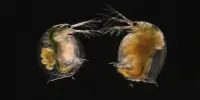Communication technologies (media and appropriate inscription tools) have evolved in tandem with shifts in political and economic systems, and thus power systems. Communication can range from very subtle exchanges to full conversations and mass communication. The history of communication can be traced back to the origins of speech around 100,000 BCE. The use of technology in communication can be traced back to the first use of symbols around 30,000 years BCE. Among the symbols used are cave paintings, petroglyphs, pictograms, and ideograms.
Acoustic communication is common not only in land vertebrates such as birds and mammals, but also in reptiles, amphibians, and fishes. Many of them are usually considered mute, but in fact show broad and complex acoustic repertoires. According to researchers, the evolutionary origin of vocal communication dates back more than 400 million years.
Singing birds, croaking frogs, and barking dogs are just a few well-known examples of vertebrates that use vocalizations as a means of communication. These vocalizations are important in parental care, mate attraction, and a variety of other behaviors. Despite its significance, little is known about when and where this behavior first appeared in the evolutionary history of vertebrates. Comparative analyses can shed light on the evolutionary origins of acoustic communication, but they are frequently hampered by a lack of data from key groups that have not been extensively studied.
We were able to reconstruct acoustic communication as a shared trait among these animals, which is at least as old as their last common ancestor, who lived approximately 407 million years ago.
Marcelo Sánchez
Acoustic abilities are widespread in land vertebrates
As a result, an international research team led by the University of Zurich (UZH) has focused on species that have never been studied before. Their research includes evidence for 53 species of land vertebrates from four major clades, including turtles, tuataras, caecilians, and lungfishes, in the form of vocal recordings and contextual behavioral information accompanying sound production.
“This, along with a broad literature-based dataset including 1800 different species covering the entire spectrum shows that vocal communication is not only widespread in land vertebrates, but also evidence acoustic abilities in several groups previously considered non-vocal,” says first author Gabriel Jorgewich-Cohen, PhD student at the Paleontological Institute and Museum of UZH. Many turtles, for example, which were thought to be mute are in fact showing broad and complex acoustic repertoires.

Last common ancestor lived about 407 million years ago
To investigate the evolutionary origins of acoustic communication in vertebrates, the researchers combined relevant data on vocalization abilities of species such as lizards, snakes, salamanders, amphibians, and dipnoi with phylogenetic trait reconstruction methods. Using data from well-known acoustic clades such as mammals, birds, and frogs, the researchers were able to map vocal communication in the vertebrate tree of life. “We were able to reconstruct acoustic communication as a shared trait among these animals, which is at least as old as their last common ancestor, who lived approximately 407 million years ago,” explains Marcelo Sánchez, the study’s lead author.
Acoustic communication did not evolve multiple times
So far, scientific consensus has favored a convergent origin of acoustic communication among vertebrates because the morphology of the hearing apparatus and its sensitivity, as well as the morphology of the vocal tract, differ significantly among vertebrates. However, the available evidence for this hypothesis, according to the UZH researchers, lacks relevant data from key species that have previously been considered non-vocal or neglected. “Our findings indicate that acoustic communication did not evolve multiple times in different clades, but rather has a common and ancient evolutionary origin,” Sánchez concludes.
















